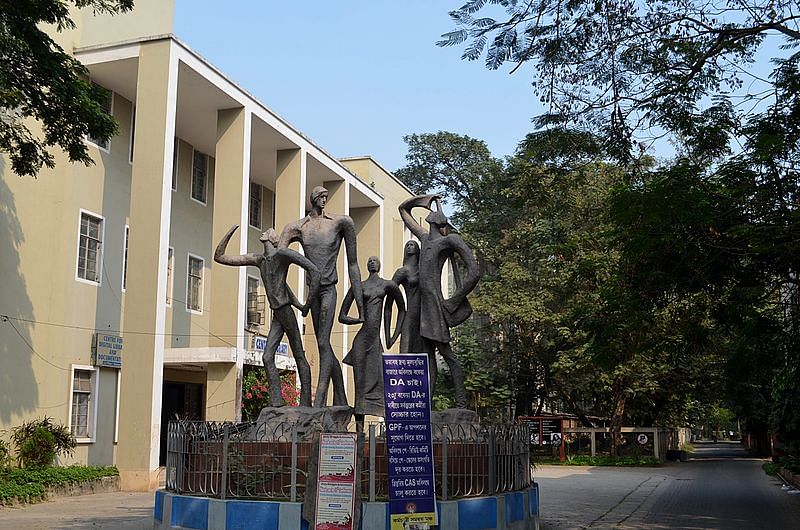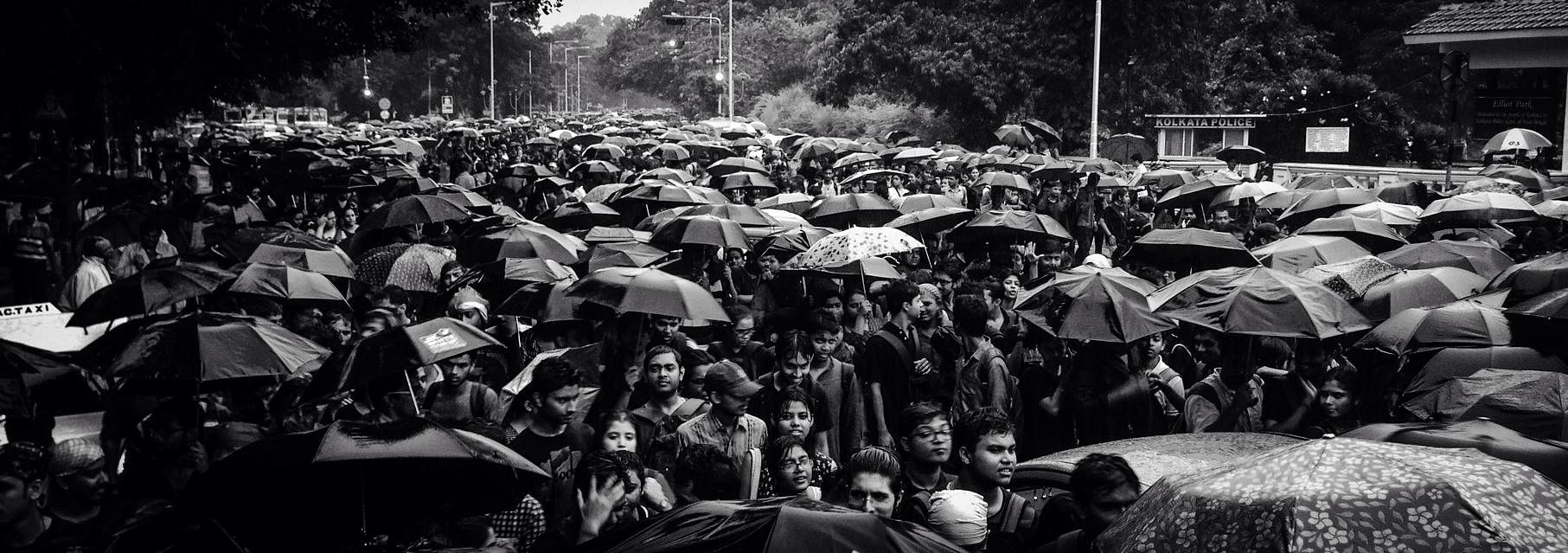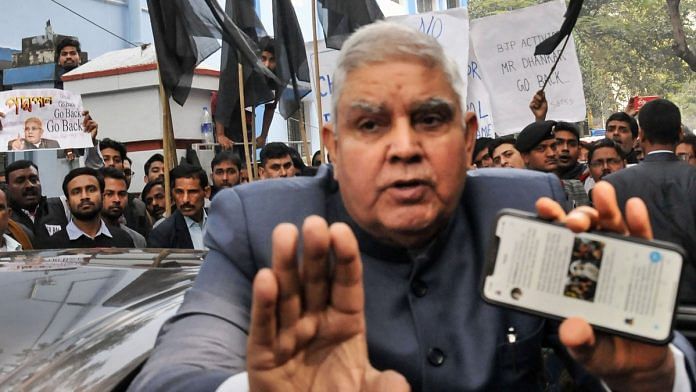New Delhi and Kolkata: Often, people ask if Jadavpur University is Kolkata’s Jawaharlal Nehru University. There’s a reason for that.
Both institutes are known to be Leftist campuses, anti-establishment and prone to protests — sometimes even violent.
So, it’s no surprise then that both Mamata Banerjee’s Trinamool Congress and the BJP have faced pushback from Jadavpur University (JU). And yet, they both still want to gain control of it.
This has played out in the recent past in the form of Union minister Babul Supriyo being heckled and Bengal Governor Jagdeep Dhankhar being kept out of the campus.
The culture of Jadavpur University (JU) has, for as long as one can remember, encouraged debate and progressive thinking, says Suchorita Chattopadhyay, professor and former student of JU.
This has been, in no small way, possible also because of the 34 years of Left Front rule in West Bengal, which left its impact on student politics, campus unions and academic syllabi.
This has, perhaps, led to the campus being irreversibly branded as a Left bastion. Students of the university are also often labelled ‘Mao-badis’ — and now ‘Urban Naxals’.
The university’s alumni include author Neel Mukherjee, filmmaker Rituparno Ghosh, first woman chairperson of SBI Arundhati Bhattacharya, noted chemist Samaresh Bhattacharya.
“This university and its students were never afraid of voicing their opinions,” says professor Partha Pratim Biswas of the Jadavpur University Teachers’ Association.
“JU has always remained an epicentre of anti-government protests. It was founded by rebels and freedom fighters. It can’t be controlled by any government, Raj Bhavan (Centre) or Bikash Bhavan (state).”
Even the founding of Jadavpur University was an act of dissent.
Also Read: Jagdeep Dhankhar isn’t first, Mamata has been on the warpath with every Bengal governor
A nationalist endeavour
If the decline of the Mughal Empire helped the British stake its claim on India, education was the tool that ensured its survival.
The empire needed “a class of persons, Indian in blood and colour, but English in taste” who could help the British rule efficiently. So, the Calcutta, Bombay and Madras Universities were set up in 1857.
But the Indian freedom struggle would have none of it. As more and more students were beaten, harassed for protesting and joining the Swadeshi movement, nationalists felt the need to set up a university that would provide an alternative to Western ideas and education.
In 1910, the National Council for Education was set up in Kolkata with generous donations from affluent Bengalis. Aurobindo Ghosh became the first principal. Rabindranath Tagore and Rashbehari Ghosh were among its benefactors.
After Independence, this would become Jadavpur University, formally established on 24 December, 1955.
It’s motto: To know is to grow.
But there is a rather dark chapter in its six-decade history.
The murder of Gopal Chandra Sen
When Gandhi was touring Bengal in the 1930s, a young boy would be drawn to his talks. Soon, he realised a problem — the crowds that gathered to listen to Gandhi could not hear him. So, he presented Gandhi with a ‘portable speaker’ he had made – the Mahatma was rather pleased.
This boy was Gopal Chandra Sen, and his Gandhian way of life was evident even to his last day.
Sen became the vice-chancellor of Jadavpur University in the late 1960s. It was also the time of great unrest in Bengal, especially among the youth who were joining the Naxal movement. Soon enough, Jadavpur University had become a hotbed of politics and mobilisation. Naxal students asked Sen to cancel the examinations. Sen disagreed. Those who wanted to boycott it could, but it would be wrong to not hold examinations for those who wanted to take it, he said.

The examinations happened. Sen even volunteered to give the pass certificates from his home, since the vacations had started. Meanwhile, the police crackdown against ‘Naxals’ in Bengal, especially Kolkata, was intensifying.
On 30 December 1970, Sen was walking back to his resident quarters. He was due to retire as V-C the next day. It was around 6 pm, and he had refused to take a ride in a colleague’s car.
Sen was killed, right in front of the library on the campus. No one knows by whom, but the murder is attributed to ‘Naxals’. Now, a memorial statue stands at the spot, a grim reminder of history.
Hok Kolorob
Former V-C Abhijit Chakraborty would cite this very murder as the reason he called the police in the early hours of 17 September 2014 to ‘remove’ protesters who had gheraoed his office building. Several students were injured in the police action.
The students’ protest was against JU administrators mishandling a sexual harassment complaint on campus and their inaction. It would soon snowball into one of the largest student movements in the country.

Thousands walked to then-Governor Keshari Nath Tripathi’s residence, the Raj Bhavan, to demand Chakraborty’s resignation and the arrest of sexual harassers. The movement was called Hok Kolorob — let there be noise.
And noise there was. So much so, that Mamata Banerjee had to come to the campus late one night to pacify students on hunger strike. Chakraborty, who was thought to be close to the Trinamool government, resigned — although not before appreciating the roses several students had given him “to get well soon”. He told The Telegraph, “They have taken care to cover the thorns (in the rose stems) with cellophane paper…. I don’t mind this form of protest.”
Also read: After JNU, Jadavpur University is the new ‘Left’ bastion everyone wants to storm
BJP-Trinamool tug of war
Between 1956 and 2019, Jadavpur University has seen several students and teachers’ protests. Be it against the Left Front government’s Nandigram violence or the Trinamool government’s decision to bar student elections on campus.
Now, the university has become the centre of struggle between the BJP and the Trinamool.
As the Left influence on state politics waned, it was the All India Trinamool Congress Chatra Parishad — the student wing of the ruling Trinamool Congress — that started spreading its dominance in colleges and universities. One by one, the universities fell. But Jadavpur University — controlled at present by Leftist SFI in Arts and independent student unions in Science and Engineering — is yet to be breached.
Both parties have been trying to enter campus politics and put their teachers in the multiple schools of JU. Gaining political significance here has a ripple effect on much of south Kolkata and the suburbs. The university has student, teachers, administrative and non-teaching staff unions.
JU’s geographical location also has a part to play. Situated in the heart of south Kolkata, the main campus is spread across almost 68 acres. Any protest here can bring Kolkata to a halt.
Politically, Jadavpur University had been a Left stronghold for decades. Jadavpur was former CM Buddhadeb Bhattacharjee’s assembly constituency. It was also the constituency from where a young Mamata Banerjee dethroned Somnath Chatterjee in the 1984 Lok Sabha elections, only to be overthrown by CPI(M) leader and JU professor Malini Bhattacharya. Now, Trinamool Congress leader and actor Mimi Chakraborty represents the constituency in the Lok Sabha.
A senior professor, who did not want to be named, said the Trinamool Congress has made significant inroads into Jadavpur University.
“Trinamool may not be visible here, but the party is very much active here. It has considerable influence on the non-teaching organisations,” he added.
A senior leader of Trinamool Congress said, “Earlier, we had no space in JU. Even though our students’ wings could manage to set up its units in many other state universities, JU was difficult to breach. We will surely set up our unit soon in the university.”
The BJP leaders also agree on the university’s political and ideological significance.
“We are not concerned about the current protests by the students. Jadavpur has always been under the influence of Leftist ideology,” says professor Mohit Roy, a former faculty member of the university and senior BJP leader.
“The students are voicing their opinions. Most of these students are from humanities, and not much from other streams. These protests are planned and backed by the non-teaching staff affiliated to the ruling Trinamool Congress. They fund such protests.”
Professor Omprakash Mishra, a senior faculty member of International Relations, told ThePrint that Jadavpur University has always remained an epicentre of all sorts of anti-government protests and movements, which are often seen as appropriate and in support of the spirit of the nation.
“The university has a tradition of upholding academic excellence as well as developing political consciousness among students,” he added.
Abhijit Gupta, head of the English department, says, “The National Council for Education (JU’s precursor) was involved with helping refugees after Partition. The student demography and hostel culture also help parties mobilise for social causes.”
“The Right forces always want to control the university, curb the autonomy of educational institutions and that’s why JU always resists,” says professor Biswas of JUTA.
As for Army paraphernalia on campus to instil nationalism, Jadavpur University already has one — a WWII British reconnaissance vehicle called the Daimler Scout car standing witness to all the politics.
Also read: ‘He didn’t answer CAA-NRC questions’ — why JU students ‘rusticated’ Chancellor Dhankhar



